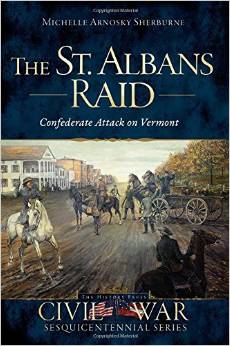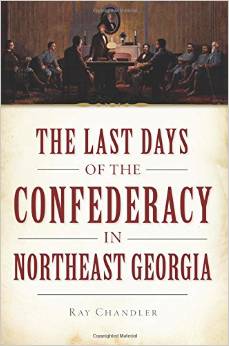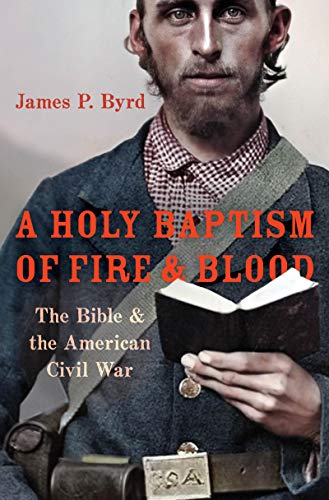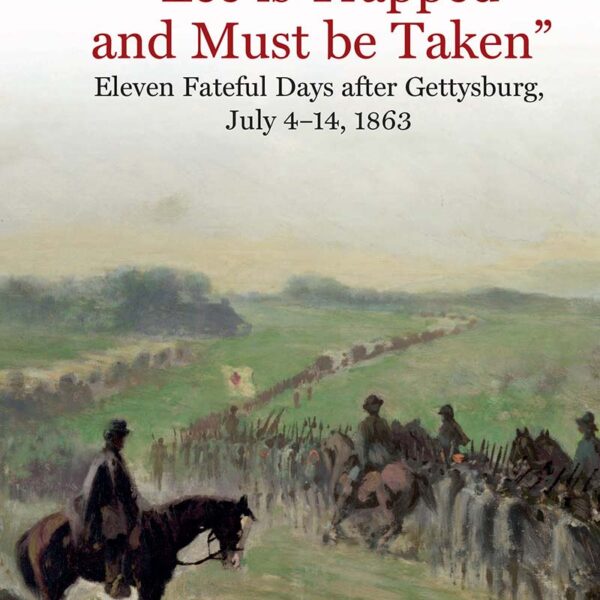The St. Albans Raid: Confederate Attack on Vermont by Michelle Arnosky Sherburne. The History Press, 2014. Paper, ISBN: 978-1626196292. $19.99.
 For most northern observers, October 19, 1864, marked one of the grandest Union victories in the Civil War at Cedar Creek—a success which permanently wrested the Shenandoah Valley from Confederate control and placed General Philip H. Sheridan in the pantheon of the Union’s most exalted commanders. To the residents of St. Albans, Vermont, however, that date held a different meaning. For that community’s inhabitants, October 19, 1864, marked a day when their once peaceful community was, in an instant, taken from blissful tranquility to a state of terror as twenty raiders from Lieutenant Bennett Young’s Fifth Company, C.S.A. Retributors, attacked the town, robbed its banks, and attempted to burn the community.
For most northern observers, October 19, 1864, marked one of the grandest Union victories in the Civil War at Cedar Creek—a success which permanently wrested the Shenandoah Valley from Confederate control and placed General Philip H. Sheridan in the pantheon of the Union’s most exalted commanders. To the residents of St. Albans, Vermont, however, that date held a different meaning. For that community’s inhabitants, October 19, 1864, marked a day when their once peaceful community was, in an instant, taken from blissful tranquility to a state of terror as twenty raiders from Lieutenant Bennett Young’s Fifth Company, C.S.A. Retributors, attacked the town, robbed its banks, and attempted to burn the community.
Despite the fact that the St. Albans Raid was the northernmost attack by Confederates during the conflict and threatened relations between the United States, Canada, and Great Britain in the midst of our republic’s most trying period, it has been largely ignored by historians. Except for Cathryn Prince’s Burn the Town and Sack the Banks: Confederates Attack Vermont, no other modern studies of the event and its aftermath exist. Perhaps in an attempt to remedy that shortfall, Michelle Arnosky Sherburne, a journalist and resident of the Green Mountain State, has produced this fast-paced, profusely illustrated, and finely crafted volume as part of History Press’ Sesquicentennial Series.
Organized into three main parts, Sherburne’s study begins by establishing historical context for the raid. In the book’s first section—consisting of eight succinct chapters—Sherburne does a commendable job of examining the Confederate government’s efforts in 1863 and 1864 to place agents in Canada who could carry out plots against the U.S. government and the Lincoln administration. All of these efforts—raids on northern cities, the liberation of Confederate prisoners of war at Camp Douglas and Johnson’s Island, and the destruction of boats in the service of the U.S. Navy—failed, except for the raid on St. Albans.
While Sherburne ably illustrates in the book’s first part how the plan to raid St. Albans fit into the larger context of the conflict, the most significant element of this book’s first section is her examination of why St. Albans proved “a perfect target” for Lieutenant Young’s command. Sherburne convincingly argues that aside from its close proximity to the Canadian border, St. Albans’ importance as a railroad and market hub made it a natural choice for Young’s Retributors.
In this study’s second section, Sherburne focuses her attention on the thirty-minute raid and the pursuit of the raiders (led by Union veteran Captain George Conger, at home in St. Albans at the time of the raid) across the border into Canada. While Sherburne’s prose is masterful in this portion of the book, her use of eyewitness accounts and newspaper coverage of the raid paints a compelling picture of the shock and horror the residents of this prosperous Vermont community felt as Young’s raiders robbed banks, shot one of its citizens, and attempted to consume the town in the flames with the use of Greek fire—an incendiary substance used frequently by the Byzantines to defend Constantinople from outside invasion. Fortunately for St. Albans’ residents, the Greek fire proved ineffective.
Beyond her first-rate chronicle of the raid and its immediate consequences, Sherburne does an extraordinary job of illustrating how Young’s attack created despair throughout Vermont, as that state’s inhabitants feared the attack was the precursor to much larger assaults from Confederates from across the Canadian border. Such fear about Vermont’s safety gripped Governor John G. Smith, whose home stood in St. Albans. He ordered militia to the community, organized temporary units to protect the border, and appealed to the War Department in Washington, D.C., for assistance—a request to which Secretary of War Edwin Stanton quickly responded.
In this book’s final section, Sherburne focuses her attention on the trials of Lieutenant Young and his raiders in Montreal. Canadian officials acquitted the raiders in two legal proceedings; a third trial should have taken place in Toronto, but did not due to waning interest in the attack.
Sherburne’s discussion of the trials, evidence gathering, and legal decisions recommends the true significance of St. Albans. While the raid was an intriguing event, the legal proceedings that followed in Canada could have transformed this half hour attack into an international crisis, threatening relations between the United States, Canada, and Great Britain. It certainly strained relations between the governments and gave Northerners a negative view of Canadians—people who treated Young’s raiders like royalty, rejoiced at their acquittal, and gave safe haven to “rebels, miscreants, thieves, and anti-American forces” (151). Despite the trials’ results and uproar among northerners, Sherburne shows that supporters of the Union had to accept the results and move forward.
While the nation might have moved on from the raid, Sherburne makes it clear that St. Albans’ residents would not forget this tragic time. When the community planned a commemoration of the raid in 1904, residents who were alive during the raid refused to invite Lieutenant Young.
Sherburne’s book, despite the absence of endnotes, should appeal to those seeking a better understanding of the raid, the Confederacy’s clandestine plans against the North, and some of the Civil War’s international dimensions.
Jonathan A. Noyalas is Assistant Professor of History & Director of the Center for Civil War History at Lord Fairfax Community College.




